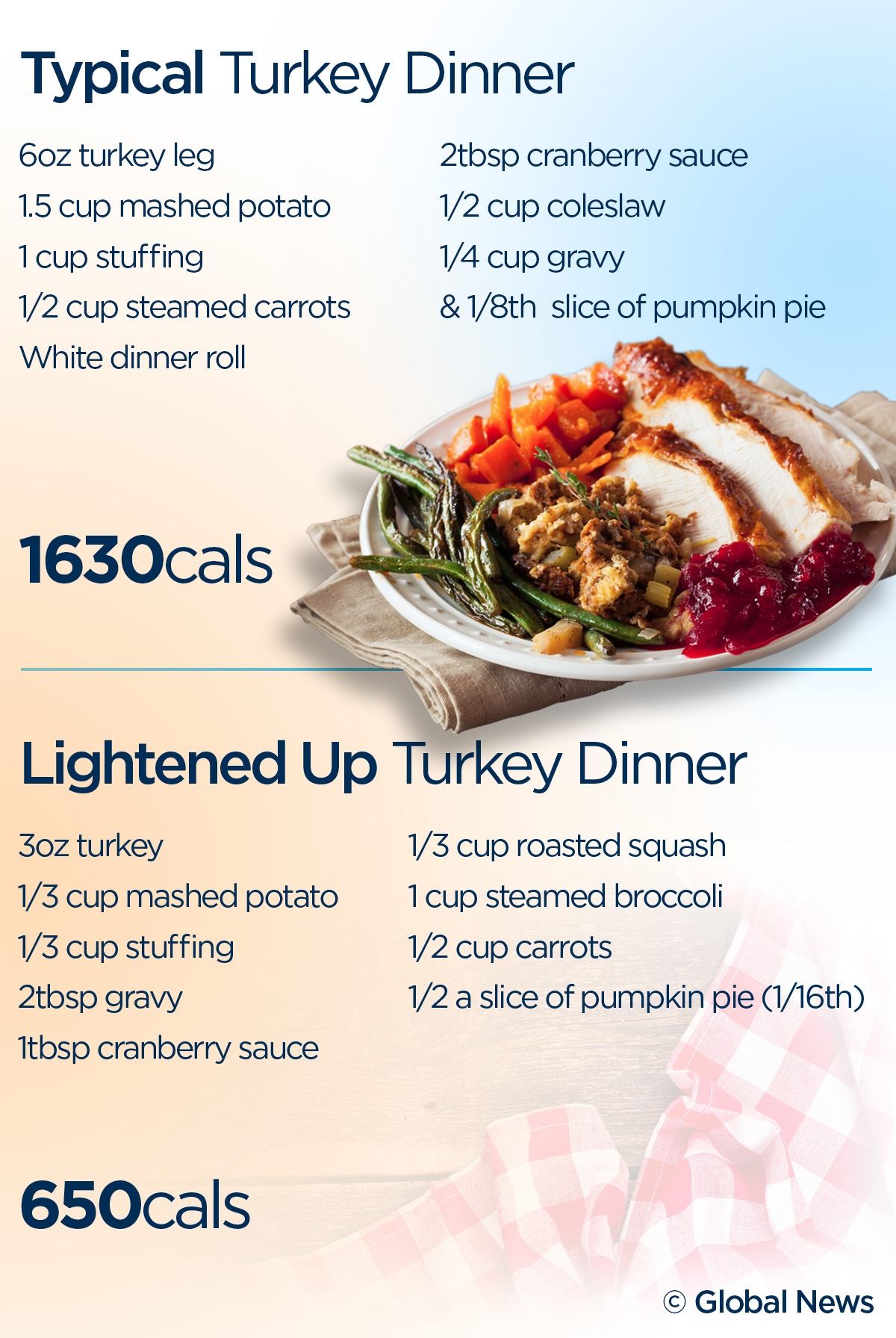There’s the turkey, mashed potatoes with gravy, some cranberry sauce and stuffing, and don’t forget the pumpkin pie. How bad could Thanksgiving dinner be?

According to some estimates, Canadians could pile up to 2,000 calories (or more if you’re going for seconds) onto their dinner plates at Thanksgiving. For some of us, that’s more than a day’s worth of calories in one sitting.
“It is very easy to end up in a caloric overload with a typical Thanksgiving feast as we are surrounding by choice and almost limitless portions,” Krista Leck Merner, a Halifax-based registered dietitian, told Global News.
“Rest assured, with a few swaps and some attention to portion sizes, you can still enjoy your Thanksgiving dinner while maintaining your weight loss goals,” Susan Macfarlane, a registered dietitian at the Bariatric Medical Institute in Ottawa, said.
READ MORE: 9 tips for healthy holiday eating
Here’s a look at how you can shave off more than 1,000 calories from your Thanksgiving dinner along with a list of easy swaps you can make that’ll spare you excess calories, salt and sugar.
Organize your plate: Nicole Osinga, a registered dietitian from Courtice, Ont., tells her clients to focus on the “healthy plate” method. Half of your plate should be covered in vegetables (carrots, green beans, Brussels sprouts, broccoli, salad), a quarter of it should be carbohydrates and starches (potatoes, stuffing and a bread roll), and a quarter should be protein (turkey).
White meat turkey is your best bet: Stacked next to ham or roast beef, the traditional turkey dinner is healthiest, especially if you’re reaching for white meat, such as skinless breast meat, Leck Merner said. Keep portions in check by eating a serving of about three ounces, Macfarlane suggests. That’s about the size of a deck of cards.
READ MORE: Here’s what your portion sizes should look like
Another option: forgo the turkey altogether and go for plant-based proteins, such as lentils or seitan to fill you up.
Rethink your potatoes: Buttery, creamy mashed potatoes with gravy are incredible but sweet potatoes and yams get the job done, too. The latter is packed with nutrients, such as potassium, vitamin C, manganese, copper and carotenoids and they’re lower on the glycemic index, Macfarlane said.
If you’re going to stick to mashed potatoes, use skim milk or low sodium broth for flavour instead of cream or butter, Leck Merner suggests. And you’ll increase the fibre content in your meal by leaving the skin on and roasting the potatoes.
Make your stuffing count: Osinga said stuffing is a staple you can hang onto but when you’re preparing it, pack it with vegetables and fruit, such as celery, apples, whole cranberries mushrooms, and onions. Use whole grain bread, wild rice or farro.
READ MORE: 7 high-fibre foods that help with losing weight, feeling full
If you’re going with stuffing, ask yourself if you really need a bread roll, Macfarlane said. If you decide you do, make sure it’s whole grain over white for an extra boost of fibre, Leck Merner said.
Load up on colourful veggies: Remember, vegetables are making up half of your plate, according to the experts’ advice. Choose deep, dark, nutrient-rich vegetables to ramp up the nutrition. They’ll fill you up with fibre and they don’t rack up as many calories while taking up space on your plate, Leck Merner said. Osinga likes kale, shaved Brussels sprouts and pomegranates.
READ MORE: The 41 most nutrient-dense fruits and vegetables
Use gravy as a condiment instead of a smothering: If you normally drench your potatoes, turkey and stuffing in a sea of gravy, this time try using it as a dip. Osinga said this could limit your gravy intake to about one tablespoon.
Don’t starve all day: Healthy eating begins before Thanksgiving dinner even starts, according to Macfarlane.
“Many people try to ‘save’ their calories by skipping meals or eating very little in the hours leading up to dinner. This is a recipe for disaster as being excessively hungry can trigger people to eat quicker than usual,” she warned.
READ MORE: Trying to lose weight? 10 tasty foods you’ll like and can eat guilt-free
The end result? Overeating. Pace yourself, and have a protein-packed snack with fibre about two hours before dinner if you’re hungry.
A slice of pumpkin pie is OK: If you’re only giving yourself a taste of the mashed potatoes and turkey and aren’t going back for seconds, you may have saved enough room for dessert. Pumpkin pie has fewer calories and sugar than apple pie or the pumpkin cheesecakes. Try to avoid adding ice cream or whipped cream — those toppings are an easy 100 to 200 calories.
Try not to drink away your calories: This means staying away from soda, juice, and alcohol. Regan suggests limiting yourself to a glass of wine, or a wine spritzer.
READ MORE: 8 so-called ‘healthy’ foods registered dietitians wouldn’t (or rarely) eat
Take a hike: So you couldn’t stop yourself. It’s OK, but instead of lying down and taking a nap after dinner, head out for a family walk around the neighbourhood. This will help with digestion and help you fight lethargy, Macfarlane said.
(Graphics created by Deepak Sharma, Matthew Peleshok/Global News)
carmen.chai@globalnews.ca
Follow @Carmen_Chai





Comments